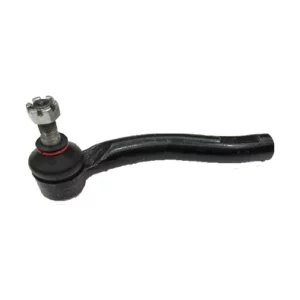Updated on October 7, 2023
What are the steps involved in replacing a tie rod end?
Replacing a tie rod end involves several steps. Here’s a general guide on how to replace a tie rod end in a car:
Safety First: Ensure that the vehicle is parked on a level surface and engage the parking brake. Use wheel chocks to secure the wheels that will remain on the ground.
Raise the Vehicle: Use a jack to lift the front of the vehicle off the ground. Place jack stands under the frame or recommended lifting points for added stability and safety.
Remove the Wheel: With the vehicle raised and secured, remove the wheel on the side where the tie rod end is being replaced. Use a lug wrench or socket to loosen the lug nuts, then remove the wheel.
Access the Tie Rod End: Locate the tie rod end, which is connected to the steering knuckle. It will have a threaded stud on one end and a ball joint or castle nut on the other end. Depending on the specific vehicle, you may need to remove any obstructions, such as dust covers or stabilizer bar links, to access the tie rod end.
Loosen and Remove the Castle Nut: Use an appropriate wrench or socket to loosen and remove the castle nut that secures the tie rod end to the steering knuckle. Depending on the design, you may need to use a cotter pin or similar device to secure the castle nut.
Separate the Tie Rod End: Use a tie rod end separator tool or a ball joint separator tool to separate the tie rod end from the steering knuckle. Apply appropriate force and leverage to separate the components. Be cautious not to damage the surrounding parts.
Remove the Tie Rod End: Unscrew the tie rod end from the inner tie rod using an appropriate wrench or adjustable pliers. Make note of the number of turns required for removal, as this will help in reinstalling the new tie rod end to maintain proper alignment.
Install the New Tie Rod End: Screw the new tie rod end onto the inner tie rod using the recorded number of turns. Ensure that it is tightened securely, but avoid over-tightening.
Reconnect the Tie Rod End: Reconnect the tie rod end to the steering knuckle by inserting the ball joint or threaded stud into the appropriate socket or opening. Secure it in place with the castle nut and tighten it to the manufacturer’s specifications. Use a new cotter pin or similar device to secure the castle nut.
Reassemble and Test: Reinstall any removed obstructions, such as dust covers or stabilizer bar links. Install the wheel, tighten the lug nuts, and lower the vehicle from the jack stands. Finally, test the steering and suspension system to ensure proper functionality and alignment. It’s recommended to have a professional alignment performed to ensure proper wheel alignment.
Please note that the specific steps may vary depending on the make and model of the vehicle. It’s always advisable to consult the vehicle’s service manual or seek professional assistance for accurate instructions and guidance tailored to your specific vehicle.
How often should tie rod ends be inspected and replaced?
Tie rod ends play a crucial role in a vehicle’s steering system, and their condition directly affects steering control and safety. The frequency of inspection and replacement for tie rod ends can vary depending on several factors, including the vehicle’s make and model, driving conditions, and maintenance practices. Here are some general guidelines:
Regular Inspections: It is recommended to have tie rod ends inspected as part of routine vehicle maintenance, such as during oil changes or tire rotations. A visual inspection of the tie rod ends can help identify any signs of wear, damage, or looseness. Additionally, if you notice any symptoms of a failing tie rod end, such as excessive play in the steering, vibration, or uneven tire wear, an inspection should be performed promptly.
Manufacturer’s Recommendations: Consult the vehicle manufacturer’s guidelines or service manual for specific recommendations on tie rod end inspection and replacement intervals. car tie rod end for sale They may provide mileage or time-based intervals for inspection and replacement based on the vehicle’s design and specifications.
Driving Conditions: If you frequently drive on rough roads, encounter potholes, or drive in challenging conditions that put additional stress on the suspension and steering components, it is advisable to inspect tie rod ends more frequently. These conditions can accelerate wear and increase the likelihood of damage to tie rod ends.
Replacement when Necessary: Tie rod ends should be replaced when they show signs of wear, damage, or excessive play. If an inspection reveals worn or damaged tie rod ends, or if there is significant looseness in the joint, replacement is typically recommended. It’s important to address worn or damaged tie rod ends promptly to maintain steering control and prevent further damage to the steering system.
Ultimately, regular inspections and proactive maintenance practices are key to identifying and addressing any issues with tie rod ends. If you’re uncertain about the condition of your tie rod ends or when they should be replaced, it’s advisable to consult a qualified mechanic or technician who can assess your specific vehicle and provide appropriate recommendations based on its condition and usage.


